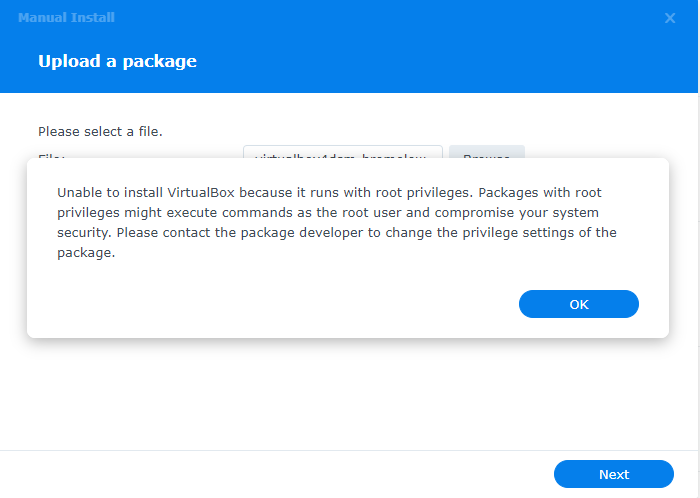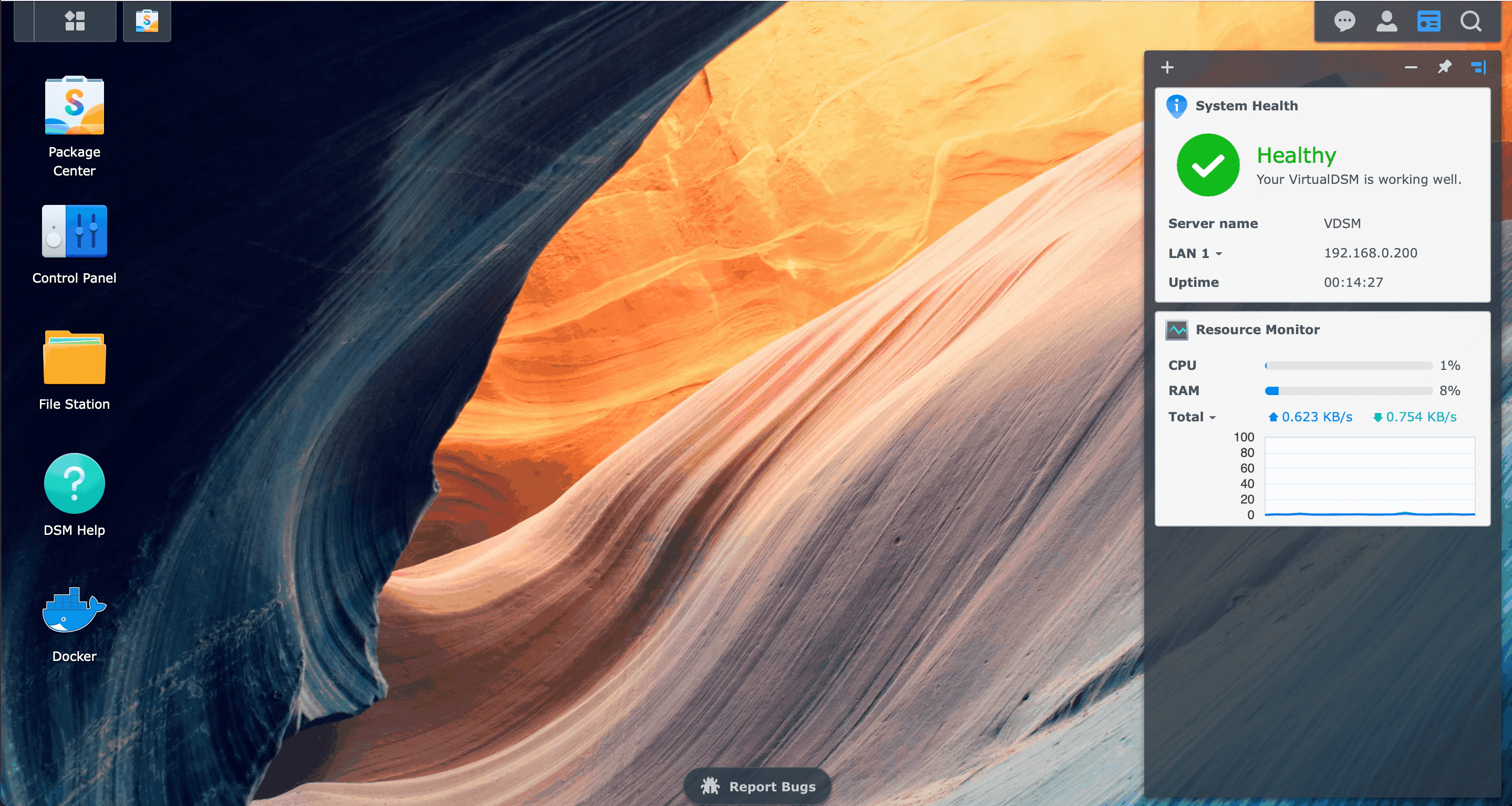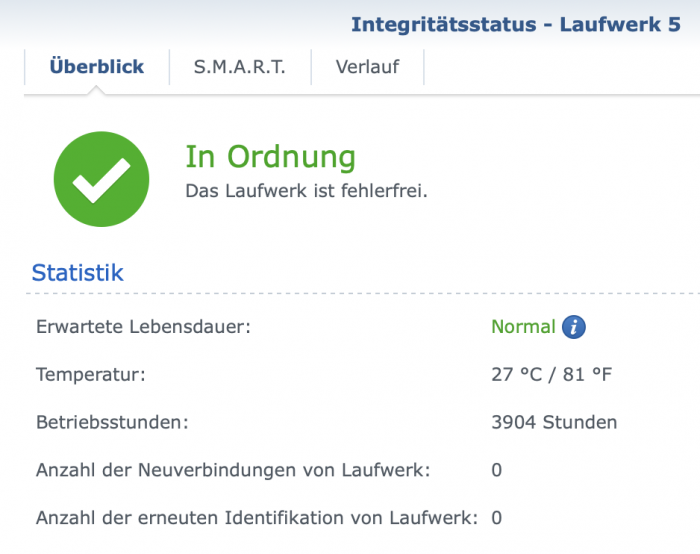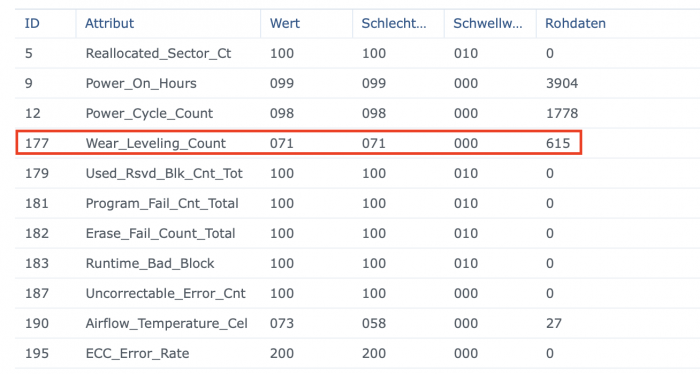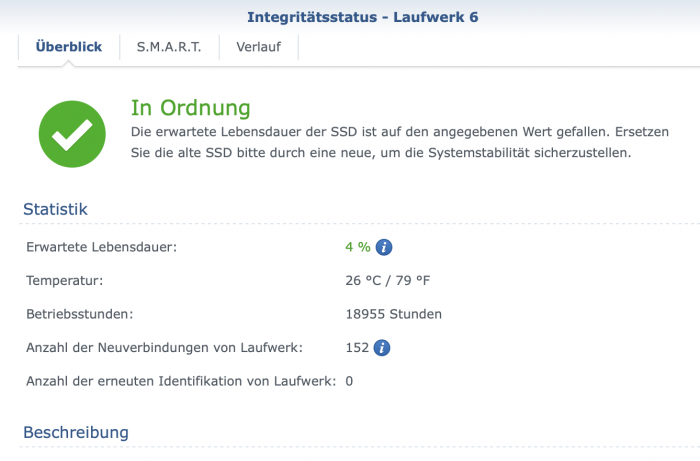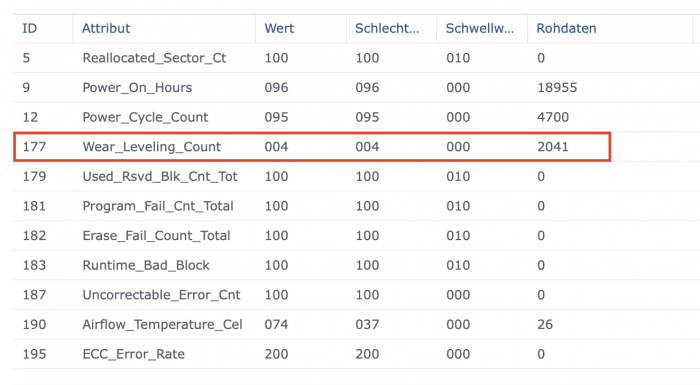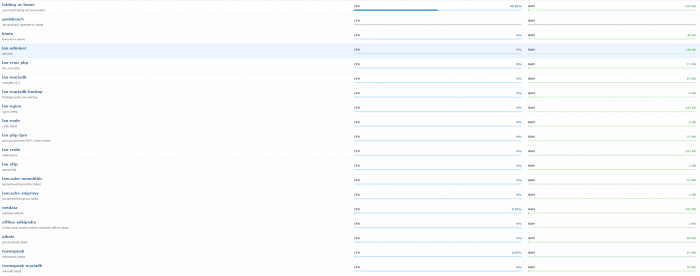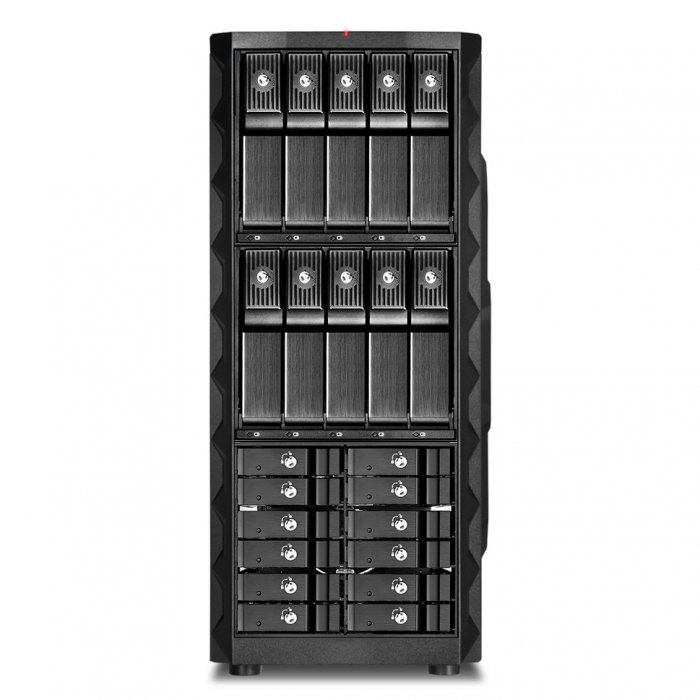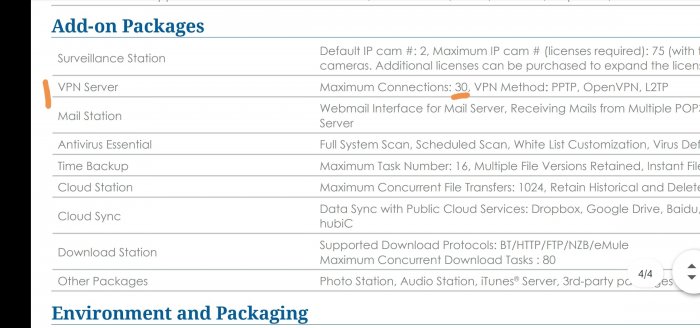
smileyworld
Member-
Posts
69 -
Joined
-
Last visited
-
Days Won
1
Everything posted by smileyworld
-
Virtualbox.spk cant be installed in DSM 7
smileyworld replied to smileyworld's question in General Questions
Unfortunately my problem starts one hop earlier. I asked this question because I want to have a VM which is connected via VPN and is able to run another (Virtualbox) VM in it. So basically what I need is nested virtualization. Has anyone got this working in DSM? I tried it with VMM from Synology and Virtualbox but no matter which operating system I use as soon as I try to add a VM in virtualbox in the nested VM I get this message: "Invalid Settings Detected" System : Acceleration page On the host (DSM 6.2) cat /sys/module/kvm_intel/parameters/nested is giving me "N" as answer, which means nested VMs are not activated but unloading the module modprobe -r kvm_intel and editing/activating the nested feature didn't work # modprobe kvm_intel nested=Y Any ideas?- 3 replies
-
- virtualbox
- dsm 7
-
(and 2 more)
Tagged with:
-
- 3 replies
-
- virtualbox
- dsm 7
-
(and 2 more)
Tagged with:
-
MainNAS 4x WD RED HDDs in RAID 10 sudo dd if=/dev/zero of=/volume1/homes/lan/testx bs=4096M count=1 conv=fdatasync oflag=direct 0+1 records in 0+1 records out 2147479552 bytes (2.1 GB) copied, 14.1281 s, 152 MB/s 4x SanDisk Ultra 3D SSDs in RAID 0 sudo dd if=/dev/zero of=/volume2/cache/testx bs=4096M count=1 conv=fdatasync oflag=direct 0+1 records in 0+1 records out 2147479552 bytes (2.1 GB) copied, 1.99687 s, 1.1 GB/s
-
@amikot was asking me how to implement a RAMDISK in DSM and I found this guide. So many thanks to mark and as usual I don't accept any liability for any data loss or damage caused by using this tutorial(s). I wrote a little script which adapts to your environment and asks if you would like to specify the amount of RAM in percent or GB the amount of RAM which should be used for the Ramdisk an existing folder where your RAMDISK should be created. E.g. /volume1/ramdisk You have to save the following lines as "create_ramdisk.sh" run it, answer the questions and add two tasks (which is demonstrated in the gif) to the task scheduler: #!/bin/bash echo Do you want to specify the amount of RAM, which should be used for the RAMDISK, in percent or in GB? read ram_unit if [ $ram_unit = 'percent' ]; then echo Please type in the amount of RAM which should be used. E.g. 2 for 2GB or 2 percent depending on your former choice read ram_amount elif [ $ram_unit = 'GB' ]; then read ram_amount else echo "Please enter percent or GB" read ram_unit echo Please type in the amount of RAM which should be used. E.g. 2 for 2GB or 2 percent depending on your former choice read ram_amount fi echo Please type in an existing folder where your RAMDISK should be created. E.g. /volume1/ramdisk read path mkdir $path/ramdisk mkdir $path/ramdisk-local if [ $ram_unit = 'percent' ]; then echo "#!/bin/sh mount -t tmpfs -o size="$ram_amount"% ramdisk $path/ramdisk sleep 1 rsync -ahW --no-compress $path/ramdisk-local/ $path">| $path/mount-ramdisk.sh else echo "#!/bin/sh mount -t tmpfs -o size="$ram_amount"G ramdisk $path/ramdisk sleep 1 rsync -ahW --no-compress $path/ramdisk-local/ $path">| $path/mount-ramdisk.sh fi echo "#!/bin/sh rsync -ahW --no-compress --delete $path/ramdisk/ $path/ramdisk-local/">| $path/sync-ramdisk.sh one for mounting the ramdisk when booting your NAS the second is a rsync job to copy the files from the ramdisk to a ssd/hdd here is the command for listing your ramdisk after creating and mounting it df | grep "ramdisk" here is the command for testing speed but keep in mind to adapt your path and RAM amount to your environment sudo dd if=/dev/zero of=/volume1/ramdisk/ramdisk/test1.img bs=30G count=1 oflag=dsync For anyone wondering: ramdisk refers to the content which is temporarily saved in your ram ramdisk-local is the copied content from the ramdisk to your hdd/ssd Unmounting the ramdisk is possible via rebooting your NAS or running this command: umount ramdisk
-
S.M.A.R.T end of lifetime (SSDs)
smileyworld replied to smileyworld's question in Answered Questions
RAM disks aren't new to me, but I didn't know that DSM supports it. I already found a guide on how to implement it. I guess for read-only it would be fine but the SSD adviser reported that I have 25GB of "hot" and 1TB of "warm" storage. Unfortunately the recommendation for a SSD cache is 170GB and my CPU only supports 64GB RAM total. I will buy Samsung PM883 SSDs and will let them run in RAID1 (with checked "skipping sequential I/O" box). -
S.M.A.R.T end of lifetime (SSDs)
smileyworld replied to smileyworld's question in Answered Questions
Thanks, now I get it. I know my SSD choice wasn't the best but it was at the beginning for testing purpose only. What du you think, is it better to replace the drive with a synology SAT5200 or would it be enough to buy a samsung pro ssd? -
I used two used Samsung EVO 256 GB SSDs as SSD Cache for about one year and a half. Now DSM notified me about the SSDs estimated lifetime reaching end. When looking at the values of my SMART tests I am unsure what to believe. As far as I know DSM predicts the lifetime based on the Wear_Leveling_Count. However when comparing the SMART values those two SSDs makes it unclearer for me. DSM reports this SSD is OK, although the "raw value" is way higher than the limitthreshold whereas this SSD should be replaced So is there a possibility that DSM or the SMART test isn't reading the values properly or am I misinformed?
-
Docker do I really need it and what's next ?
smileyworld replied to Onknight's topic in Third Party Packages
At the start I didn't saw the advantage of docker but a few month later I can't imagine running DSM without it. In the screenshot you can see just a few containers I run. The containers with lan- as prefix are for developing websites. One of the biggest pros which got me into docker was pi-hole and lancache. If you would like to know more about those two you can have a look at this: -
Your CPU supports 25 TDP-down and I think @IG-88assumed you actived it since you want to lower power consumption. IF your Mainboard supports undervolting you need to be carefully. I reduced my voltage in 10 mv steps until it got my system unstable when CPU stress testing and added 40 mv to this value. E.g. 1,1 volt is default value, 910mv is where it gets unstable and you set it to 950. This method assumes you have a fix Vcore. But in theory it also works with adaptive or offset. BTW I forgot to mention that my NAS runs lots of docker containers and one of them is folding at home, which needs about 40% CPU processing power. This adds 20-40 Watt. Without the container my MainNAS only consumes 85 Watt average.
-
I don't think so. I am running DSM baremetal on an i3-8100 and as far as I know the hardware choices is where you can save energy most easily. Meaning you can lower comsumption mostly by choosing a power efficient CPU and put only drives in your NAS you need, because every HDD needs power as well. You could however undervolt your CPU slightly if the motherboard allows it. I hooked a power consumption measuring device (MyStrom wifi) between my NAS and my wall socket. It is a pretty cool device which offers an API to grab the current power draw and can be integrated in Netdata (if you are into that). I attached a screenshot of the power consumption, however keep in mind that my MainNAS is quipped currently with a combination of 14 HDDs/SSDs.
-
Security: brute-force attack against Synology NAS
smileyworld replied to jensmander's topic in Readers News & Rumours
I only had once an incident where someone from russia tried to login in my NAS in Austria multiple times and then got blocked automatically by DSM. After that I changed my firewall settings inside DSM so that only ports from the services I need are allowed and restricted it just to my country. My point is as @IG-88 already mentioned when you follow the instructions you should be safe.- 14 replies
-
Increasing max number of concurrent VPN connections
smileyworld replied to smileyworld's topic in Packages & DSM Features
I didn't need all 30 till today, but in case anyone is interested and doesn't want to fiddle around with docker try ssh on your NAS and editing the openvpn.conf of your server/NAS. I guess you could increase the clients by setting max-clients 30 to something higher. See for yourself: vi /var/packages/VPNCenter/etc/openvpn/openvpn.conf -
@IG-88glad I could help. Yeah I don't like noisy server either😅
-
I am not sure if it fit your needs but have a look at those: https://www.aliexpress.com/i/32830477668.html https://www.realpower.de/media/filer_public/106155.pdf
-
I am using a Sharkoon REX8 Value in combination with hot swap enclosures from Silverstone. It's probably cheaper to buy a rack enclosure but I didn't want to have a loud NAS and I don't like how much space they need horizontally. For my second NAS I use a Node 304 as well. Both are silent and temps are great!
-
Fix the problem of moments 1.3.x face recognition NOT work
smileyworld replied to G Jie's topic in Synology Packages
Worked for me on my main NAS. -
Anybody tried DSM 6.2.3-25426-3 yet?
smileyworld replied to stephan1827's question in General Questions
I updated a week ago and I had no issues at all. -
Asus B460M-A Motherboard only works with 918+ ?
smileyworld replied to smoothmove's topic in DSM 6.x
I found out that the onboard NIC works with an extra.lmza but the NIC was behaving oddly and the NAS is intended to be used in a productive environment so that was no option for me. Therefor I bought an Intel E1G42ETBLK ET Dual Gigabit NIC which is natively supported by Synology. Nevertheless thanks for the tip. -
- Outcome of the update: SUCCESSFUL - DSM version prior update: DSM 6.2.3-25426 Update2 - Loader version and model: Jun's Loader v1.03b - DS3615XS - Using custom extra.lzma: NO - Installation type: BAREMETAL - ASRock Z370M Pro4 | i3 8100 - Additional comments: for more information about my hardware have a look at my MainNAS signature
-
- Outcome of the update: SUCCESSFUL - DSM version prior update: DSM 6.2.2-25426 - Loader version and model: Jun's Loader v1.03b 3617XS - Using custom extra.lzma: No - Installation type: BAREMETAL - Intel 10400T + ASRock H410M-ITX - Additional comment: Lagacy BIOS required. Onboard NIC is not working without an extra.lzma -> Anyway, I used an Intel E1G42ETBLK ET Dual Gigabit NIC. For fully specs read my SecondaryNAS signature
-
Asus B460M-A Motherboard only works with 918+ ?
smileyworld replied to smoothmove's topic in DSM 6.x
I should have read your table first. I switched HT back to on and now I get 4605, which I am perfectly fine with. You made my day and I appreciate your help🍻 -
Asus B460M-A Motherboard only works with 918+ ?
smileyworld replied to smoothmove's topic in DSM 6.x
Thanks for the hint. I disabled HT and changed the loader to ds3617xs 1.03b. It gave me a small performance boost. But nonetheless I didn't get the performance I was hoping for. I now get 4082 Multi-Core Score in Geekbench compared to another user who gets 4845 points. One reason could be that I've only one DDR4 slot in use and the CPU is optimized for dual channel. I am open minded if someone has anything else which I could try. -
Asus B460M-A Motherboard only works with 918+ ?
smileyworld replied to smoothmove's topic in DSM 6.x
I've been able to get an intel 10400t CPU and ASRock H410M-ITX/ac motherboard up and running in combination with the 1.03b DS3615xs loader, however DSM recognizes only 8 cores. I've read somewhere that this is the limit DS3615xs but I am not quite sure if this is the reason. The geekbench result is also comparable low (My system got 3700 points whereas other 10400t users have more than 4500 Geekbench 5 multi score) Interestingly the onboard NIC Intel-219V wasn't recognized by DSM, but it is working perfectly on my main NAS (ASRock Z370M Pro4). Any ideas why the onboard NIC work on the second mainboard and doesn't on the ASRock H410M-ITX/ac? -
I am currently using the VPN-server package of Synology and I'm wondering if it is possible to increase the maximum number of concurrent VPN connections from 30 (limit for ds3615xs) to for example 50 by editing a config file of DSM. If so, than please tell me what to do. Would appreciate the help. Cheers
-
- Outcome of the update: SUCCESSFUL - DSM version prior update: DSM 6.2.3-25426 - Loader version and model: Jun's Loader v1.03b DS3615xs - Using custom extra.lzma: No - Installation type: BAREMETAL
